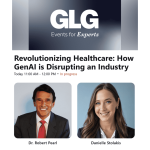A year ago, I published my latest book, ChatGPT, MD: How AI-Empowered Patients & Doctors Can Take Back Control of American Medicine. Since then, I’ve witnessed a growing acceptance of generative AI among clinicians. An increasing number of doctors are now utilizing AI tools for tasks such as transcribing patient notes, navigating insurance claims and managing administrative duties.
While these early applications are valuable, they represent only a fraction of GenAI’s potential.
Its greatest promise lies in improving medical care, saving lives, lowering costs and easing clinician burnout.
Earlier today, at Penn State College of Medicine’s AI and Human Factors Conference, I presented on the topic of “Aligning Human and Technological Factors in Health Care.” During my keynote address, I emphasized the multiple ways that importance of embracing generative AI can empower patients for improved quality and enhance safety.
Challenging human perceptions
As healthcare professionals, we too often hold technology to higher standards than we do ourselves—an attitude that leaves us vulnerable to well-documented cognitive biases, as highlighted by the work of Nobel prize winning psychologist Daniel Kahneman.
Confirmation bias leads us to favor initial diagnoses despite contradictory evidence. Availability bias causes us to rely heavily on recent experiences rather than objective research studies. Overconfidence bias produces unwarranted certainty in our decisions. These cognitive errors help explain why we often forgive human error but are quick to criticize technological mistakes.
Leveling our expectations
Consider the following statistics:
- Medical misdiagnoses contribute to approximately 400,000 deaths and a similar number of disabilities annually in the U.S.
- Medical errors result in an estimated 250,000 premature deaths each year.
- An estimated 30–50% of complications from chronic diseases (such as heart attacks, strokes, cancers and kidney failures) could be prevented through better management and improved clinical control, according to the CDC.
As clinicians, we need to ask ourselves (and study) not whether generative AI tools like ChatGPT, Gemini, Claude or DeepSeek are perfect, but whether the broad use of these technologies would save lives and prevent suffering. And the data show that they have massive potential to improve safety and help patients stay healthier, longer.
Giving clinicians the gift of time
Time scarcity contributes to medical errors, erroneous diagnoses, avoidable complications and clinician burnout. Research shows that for primary care doctors to deliver guideline-based care to all their patients, it would require 26.7 hours per day—clearly impossible. As a result, visits average only 17 minutes, with physicians interrupting patient histories after just 11 seconds. And chronic diseases that affect patients every day are managed on a three- to four-month cycle, with clinicians having little knowledge of what happens between them.
Generative AI has the potential to help doctors improve clinical outcomes, empower patients to better manage their medical problems and increase patient safety. Generative AI tools will be able to take accurate patient histories, ask relevant questions and offer diagnoses of challenging medical problems through an in-depth literature review.
Hospitals, too, are overrun by time constraints. Research has identified proven ways to eliminate medical errors such as medication mistakes, infections of catheters doctors place in arteries and veins, and pneumonia in patients intubated with breathing tubes in their lungs. And yet, often, doctors and nurses cut corners to save time rather than follow these evidence-based approaches. Using video or image recognition, generate AI will be able to monitor clinician workflow and point out the danger before errors are made.
And in the realm of chronic disease, the opportunity is perhaps greatest of all. GenAI tools linked to wearable and home-monitoring devices can track blood pressure, glucose and heart rhythms in real time. With the right prompts, these AI-powered tools can alert patients and doctors when the measured parameters aren’t responding to treatment as expected, so that effective control can be achieved before complications ensue.
Building a safer future
I believe that the next generation of generative AI tools can address many of today’s medical shortcomings, but improvement won’t happen unless clinicians embrace the technology and lead the way.
For that reason, I urged the audience to experiment with one of the available large language models and begin testing these tools today. I asked them to input complex cases into these generative AI tools, compare the analyses with their own, and consider how AI can most effectively complement their clinical judgment. And then figure out how this technology can empower patients to be partners with them in improving clinical outcomes.
I extend my gratitude to Dr. Michael Bruno for organizing this visionary conference and for recognizing the pivotal role of generative AI in the future of healthcare. As generative AI continues to double in power each year, I believe that in just three to five years, the synergy between dedicated clinicians, informed patients and intelligent technology will transform care in ways none could achieve alone.
* * *
Dr. Robert Pearl is the former CEO of The Permanente Medical Group, the nation’s largest physician group. He’s a Forbes contributor, bestselling author, Stanford University professor, and host of two healthcare podcasts. Check out Pearl’s newest book, ChatGPT, MD: How AI-Empowered Patients & Doctors Can Take Back Control of American Medicine with all profits going to Doctors Without Borders.






